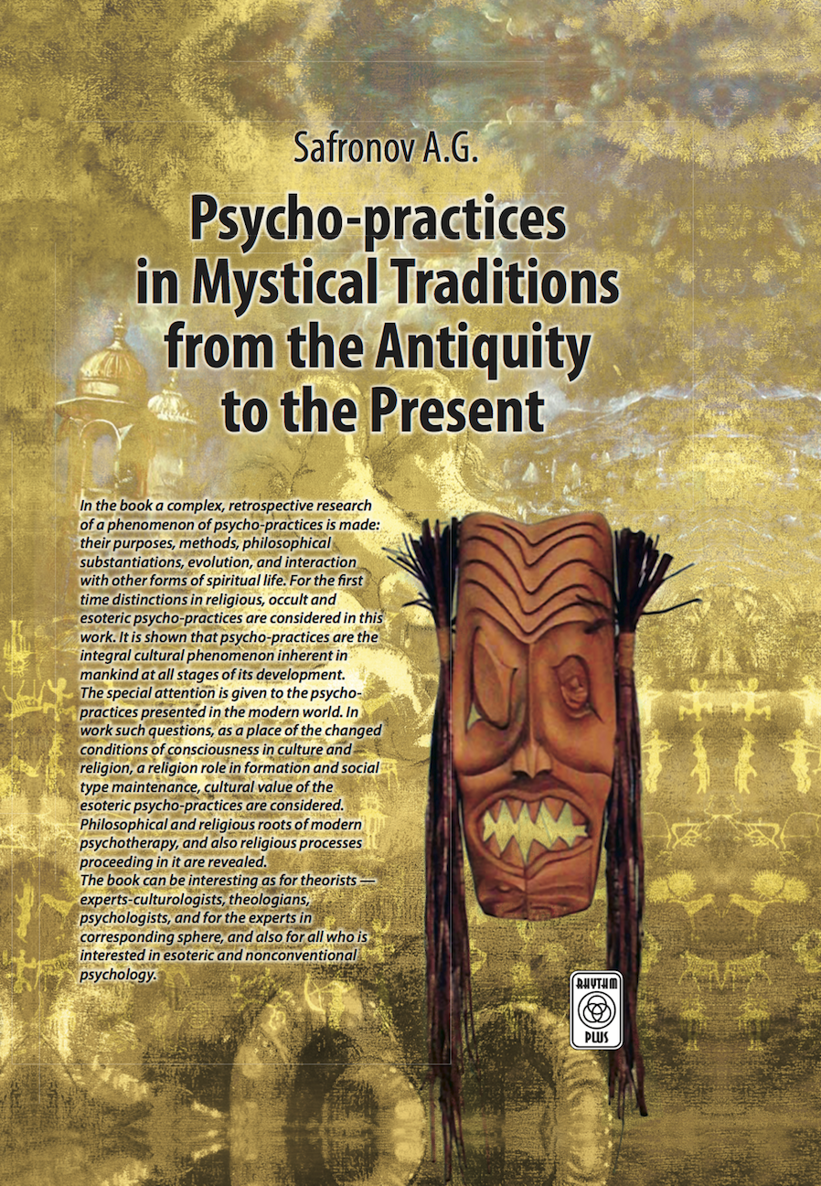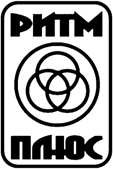

А. Г. САФРОНОВ
ПСИХОЛОГИЧЕСКИЕ
ПРАКТИКИ
В МИСТИЧЕСКИХ ТРАДИЦИЯХ:
ОТ АРХАИКИ ДО НАШИХ ДНЕЙ
Харьков
2011
ANDREY G. SAFRONOV
PSYCHOLOGICAL
PRACTICES
IN MYSTIC TRADITIONS:
FROM ARCHAIC TO OUR DAYS
Kharkov
2011
UDK 294.527
BBK 87.3
S 21
SAFRONOV A.G.
S 21
Psychological practices in mystic traditions: from archaic to our days. — Kharkov: PPB Kovalenko A.V., 2011. — 320 pgs.
ISBN 978-966-2079-36-4
Th e book represents a complex retrospective study of psychological practices phenomenon: their targets, methods, philosophical groundings, evolution and interaction with other forms of spiritual life. It gives the fi rst ever explanation of diff erences between religious, occult and esoteric psychopractices. Psychological practices are shown as an integral cultural phenomenon inherent in mankind at every stage of its evolution. Particular consideration is drawn to psychological practices employed in our days. Th e work contemplates such issues as the role of altered state of consciousness in culture and religion, the role of religion in sociotype formation and maintenance, cultural value of esoteric psychological practices. Here the philosophic and religious origins of modern psychotherapy are revealed, as wel as religious processes that take course in it.
Th e book can be of interest to both theorists — culture, religion studies and psychology experts, and corresponding sphere practicians, as wel as al those interested in esotericism and non-traditional psychology.
UDK 294.527
BBK 87.3
Al rights reserved. No part of this book can be may be used or reproduced in any form without prior written permission of the copyright owner.
ISBN 978-966-2079-36-4
© Safronov A.G., 2011
© Kovalenko A.V., 2011
© Safronov A.G., 2008
UDK 572.026
BBK 88.57
S 21
SAFRONOV A.G.
S 21
Psychological practices in mystic traditions: from archaic to our days. — Kharkov: PPB Kovalenko A.V., 2011. — 320 pgs.
ISBN 978-966-2079-36-4
In the book a complex, retrospective research of a phenomenon of psychopractices is made: their purposes, methods, philosophical substantiations, evolution, and interaction with other forms of spiritual life. For the fi rst time distinctions in religious, occult and esoteric psycho practices are considered in this work. It is shown that psychopractices are the integral cultural phenomenon inherent in mankind at all stages of its development. Th e spe cial attention is given to the psychopractices presented in the modern world. In work such questions, as a place of the changed conditions of consciousness in culture and religion, a religion role in formation and social type maintenance, cultural value of the esoteric psychopractices are considered. Philosophical and religious roots of modern psychotherapy, and also religious processes proceeding in it are revealed.
Th e book can be interesting as for theorists — experts-culturologists, theologians, psychologists, and for the experts in corresponding sphere, and also for al who is interested in esoteric and non-conventional psychology.
UDK 572.026
BBK 88.57
All rights reserved. No part of this book can be may be used or reproduced in any form without prior written permission of the copyright owner.
ISBN 978-966-2079-36-4
© Safronov A.G., 2011
© Kovalenko A.V., 2011
© Safronov A.G., 2008
Table of Contents
PREFACE .............................................................................................................9
Section 1
CONCEPTUAL FIELD: RELIGION, RELIGIOSITY,
MYSTICISM AND ESOTERICISM .....................................................12
1.1. Main Compounds of Religious Culture ..............................................12
1.1.1. Th e Issue of Defi ning the Term “Religion” .............................12
1.1.2. Th e Notions “Mysticism” and “Mystic Experience” . . . . . . . .16
1.1.3. Esoteric Systems in Religious Life-Mode .................................18
1.1.4. Approaches to Religion Study ....................................................20
1.2. Th e Problem of Correlation Between Psychological and Spiritual Experiences . . . . . . . . . . . . . . . . . . . . . . . . . . . . . . . . . . . .22
1.3. Religious Psychopractices as an Object of Scientifi c Analysis . . . .28
1.4. Anthropological Characteristic of Religious Life Elements . . . . . . .36
Section II ...........................................................................................................49
ALTERED STATES OF CONSCIOUSNESS
IN RELIGION AND CULTURE ...........................................................49
2.1. States Of Consciousness as a Cultural Value.....................................49
2.1.1. States of Consciousness — the History of Case Study . . . . .49
2.1.2. Altered States of Consciousness in Polyphasic Societies . . . 53
2.2. Altered States of Consciousness
And Phenomenon of Religious Beliefs ................................................54
2.3. Phenomenelogy of Altered States of Consciousness . . . . . . . . . . . . 57
2.4. Religious Psychopractices Aimed at Getting
into Altered States of Consciousness . . . . . . . . . . . . . . . . . . . . . . . . . 69
2.5. Altered States of Consciousness and Religious Cosmogony . . . . . .75
2.6. Altered States of Consciousness in the World of Today.
Charismatic Systems in the Context of Modern Culture . . . . . . . . 77
Section III
SOCIOCULTURAL FUNCTIONS OF RELIGIOUS
PSYCHOPRACTICES ............................................................................87
3.1. Social Character and its Role in Culture ............................................87
3.2. Religious Psychopractices and Th eir Role in Sociotype Formation and Sustention . . . . . . . . . . . . . . . . . . . . . . . . . . . . . . . . . . . 91
3.2.1. Psychopractices Based upon Psycho-Somatic Infl uence .......93
3.2.2. Cathartic Rituals ...........................................................................94
3.2.3. Psychopractices Based upon Usage of Psycho-Active Agents ...95
3.2.4. Rituals of Brain Traumatization.................................................95
3.3. Pseudo-Religious Rituals Aimed at Formation of Sociotype in Totalitarian Societies . . . . . . . . . . . . . . . . . . . . . . . . . . . . . . . . . . . . . 97
Section IV
ARCHAIC PSYCHOPRACTICES
IN PRIMEVAL AND MODERN CULTURE .......................................99
4.1. Collective Consciousness and its Archaic Compound .....................99
4.2. Th e Phenomenon of Unconscious Religiosity
and Secular Rituals . . . . . . . . . . . . . . . . . . . . . . . . . . . . . . . . . . . . . . . . 102
4.3. Psychopractices Used in Totemism . . . . . . . . . . . . . . . . . . . . . . . . . . 103
4.3.1. Totemic Initiation as a Kind of Psychopractice . . . . . . . . . .105
4.3.2. Modern Analogues of Totemic Psychopractices . . . . . . . . . .108
4.3.3. Nagualism .....................................................................................110
4.4. Psychopractices Used in Animism . . . . . . . . . . . . . . . . . . . . . . . . . . .110
4.4.1. Animism Basic Concepts and Rituals .....................................110
4.4.2. Psychological Subject-Matter of Animism
and its Psychopractices . . . . . . . . . . . . . . . . . . . . . . . . . . . . . . . 114
4.5. Primeval Magic ......................................................................................119
4.5.1. Basic Concepts of Primeval Magic..........................................119
4.5.2. Magic Rituals in Modern Culture . . . . . . . . . . . . . . . . . . . . . .120
4.5.3. Primeval Magic: Psychological Aspects
and Psychopractices . . . . . . . . . . . . . . . . . . . . . . . . . . . . . . . . . .123
4.6. Social Cults. Psychopractice Employed by Authorities . . . . . . . . . 124
4.7. Shamanism ..............................................................................................126
4.7.1. Brief Characteristic of Shamanism ..........................................126
4.7.2. Shamanism as a System of Psychopractices . . . . . . . . . . . . . 129
Section V
ESOTERIC PSYCHOPRACTICES
IN RELIGIOUS TRADITIONS ......................................................... 134
5.1. Anthropologic Contents of Esoteric Psychopractices . . . . . . . . . . .134
5.2. Cultural Value of Esoteric Psychopractices ......................................141
5.3. Psychopractices in Indian Culture . . . . . . . . . . . . . . . . . . . . . . . . . . .143
5.3.1. Yoga ...............................................................................................143
5.3.2. Tantrism........................................................................................152
5.3.3. Psychopractices of Buddhism . . . . . . . . . . . . . . . . . . . . . . . . . .156
5.3.3.1. Early Buddhism . . . . . . . . . . . . . . . . . . . . . . . . . . . . . . . . 156
5.3.3.2. Vajrayana............................................................................160
5.4. Psychopractices in Chinese Culture ...................................................165
5.4.1. Esoteric Taoism. Inner Elixir Doctrine ..................................165
5.4.2. Zen .................................................................................................167
5.5. Psychopractices in Greek Cultural Tradition ...................................168
5.6. Psychpractices in Christianity . . . . . . . . . . . . . . . . . . . . . . . . . . . . . . .170
5.7. Psychopractices in Islam. Sufi sm ........................................................181
5.8. Social Functions of Esoteric Psychopractices...................................188
Section VI
RELIGION AS ANELEMENT OF MODERN CULTURE . . . . . . . 193
6.1. Structure And Specifi c Features of Modern Religious Life...........193
6.2. Specifi c Character of Religiosity of Today:
Pchychological Analysis . . . . . . . . . . . . . . . . . . . . . . . . . . . . . . . . . . . . 207
6.3. Th e Phenomenon of Religious Mobility ............................................217
6.4. Th e Issue of “Destructive” and “Totalitarian” Cults . . . . . . . . . . . .222
Section VII
RELIGIOUS PSYCHOPRACTICES AND PSYCHOLOGICAL
METHODS IN THE CULTURES OF TODAY ................................ 227
7.1. Sociocultural Identifi cation in the World of Cultural Diversity ...227
7.2. An Individual within a Religious System:
Anthropological Analysis . . . . . . . . . . . . . . . . . . . . . . . . . . . . . . . . . . .229
7.2.1. Artifi cial Involvement of an Individual
into Religious Organization ......................................................229
7.2.2. Psychological Manipulation in Religious Systems ................231
7.2.3. Models of Personal Transformations
in Religious Groups ....................................................................236
7.3. Pseudo-Religious Psychopractices in Marginal Sub-Cultures . . . . . 242
Section VIII
PSYCHOPRACTICES IN OCCULT SYSTEMS OF TODAY . . . . 247
8.1. XXth Century Occult Doctrines as Specifi c Cultural and Historic Phenomenon ...................................................................247
8.2. Relation Between Occultism and Esotericism. Occult Psychopractices in Scope of the “Invented Tradition” Discourse . . . . . . 254
8.3. Psychological Paradigms of Modern Occultism ..............................257
Section IX
SOCIOCULTURAL FUNCTIONS OF PSYCHOTHERAPY
IN SOCIETY OF TODAY .................................................................. 267
9.1. Philosophic and Religious Sources of Psychotherapy .....................267
9.2. Th e World-Outlook and Religious Function
of Psychotherapy ....................................................................................272
9.3. “Psychological” Cults within the Context
of Modern Religious Culture . . . . . . . . . . . . . . . . . . . . . . . . . . . . . . . .275
9.4. Socio-Cultural Functions of Psychotherapy
in Modern Social Environment . . . . . . . . . . . . . . . . . . . . . . . . . . . . . 281
CONCLUSIONS ............................................................................................285
REFERENCED LITERATURE ....................................................................287





